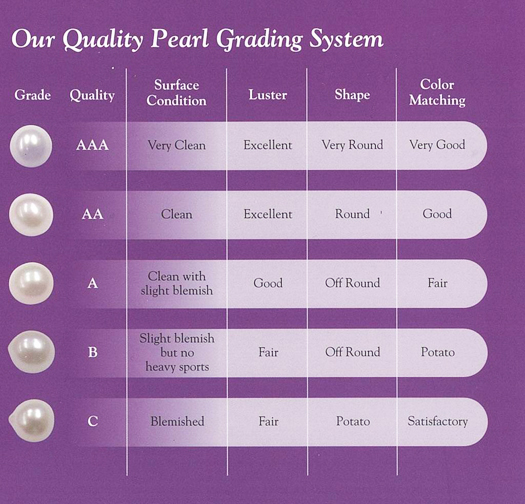Pearls
Natural pearls are formed randomly and really are coincidences of nature. As quality natural pearls are extremely rare, cultured pearls have supplanted natural pearls as the most common and available pearls since the early part of the 20th century.
Since pearls emerge from the shell as perfect little gifts, a pearl does not need to be faceted, cut then polished like most other jewelry stones. Pearls are beautiful as they are - straight out of the mollusk. For these reasons, pearls have become a symbol of purity and natural beauty.
Where They Come From
Freshwater pearls are produced by pearl farmers in China. Nowadays, the global freshwater pearl market is overwhelmingly dominated by China, which account for nearly all of the freshwater pearls sold today.
At freshwater pearl farms, each mussel is surgically implanted with 24 to 32 tiny pieces of mantle tissue and this process is known as nucleation. In response, the mussels protect their flesh from the irritants by secreting nacre, which is calcium-carbonate compound. As the nacre builds up in layers, it surrounds the irritant and eventually forms a pearl in 2 to 7 years. By the time the pearls are harvested, each mussel has produced more than two dozen pearls densely clustered on the inside of its mantle tissue.
The development of cultured pearls took much of the chance, risk, and guesswork out of the pearl industry. During the harvest, millions of pearls are sorted carefully and quality pearls in various sizes, shapes and colors are available and affordable to everyone in the market.
 |
 |
 |
 |
Pearl Luster
Luster is the measure of quantity and quality of light that is reflected from the surface, or just under the surface of a pearl. The luster of good quality pearls is sharp and bright, which you could see your reflection clearly on the surface of a pearl.
Pearl Surface
The cleaner the surface of the pearl, the more valuable it is. Look for an absence of disfiguring spots, bumps or cracks on the surface of a pearl, also known as "cleanliness." Notice that the highest quality pearls have a sharp, mirror-like reflection.

Pearl Shape
The varied shapes include round pearl, rice pearl, button pearl, coin pearl, keshi pearl, flat pearl, baroque pearl''.

Pearl Color
Freshwater Pearls comes in different colors. The most familiar colors are White, Peach, Plum, Black (Dyed) are also fairly common.

Pearl Size
Pearls are measured by their diameter in millimeters. If all other quality factors are equal, the size of a pearl will determine its value. Only a 1 millimeter increase in pearl size is a substantial jump in both appearance and value.
.jpg)
Pearl Grading System
Pearls are measured by their diameter in millimeters. If all other quality factors are equal, the size of a pearl will determine its value. Only a 1 millimeter increase in pearl size is a substantial jump in both appearance and value.





